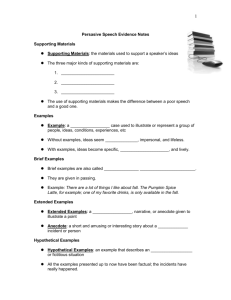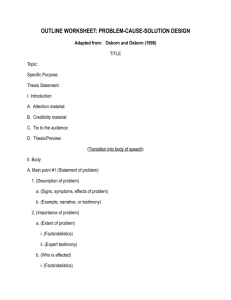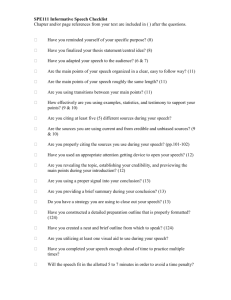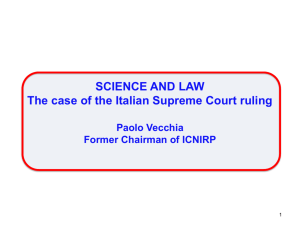File
advertisement
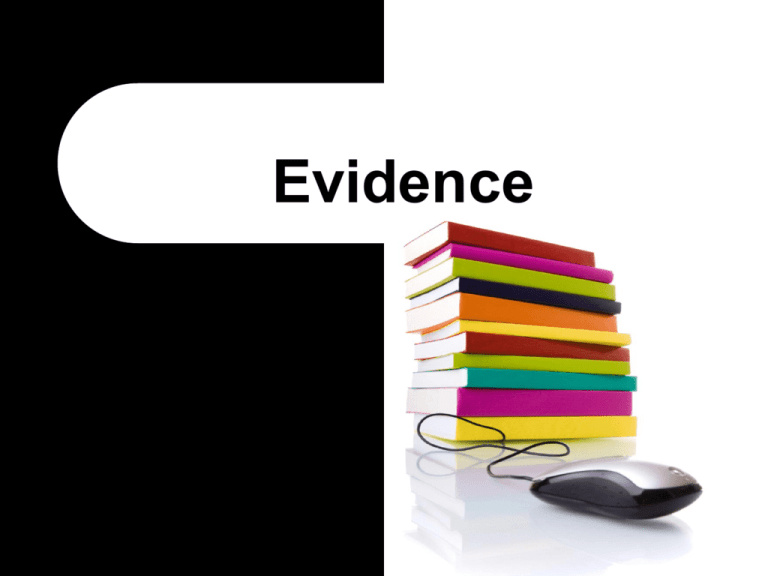
Evidence Supporting Materials Supporting Materials: the materials used to support a speaker’s ideas The three major kinds of supporting materials are: 1. Examples 2. Statistics 3. Testimony The use of supporting materials make the difference between a poor speech and a good one. Examples Example: a specific case used to illustrate or represent a group of people, ideas, conditions, experiences, etc Without examples, ideas seem vague, impersonal, and lifeless. With examples, ideas become specific, personal, and lively. Brief Examples Brief examples are also called specific instances. They are given in passing. Example: There are a lot of things I like about fall. The Pumpkin Spice Latte, for example; one of my favorite drinks, is only available in the fall. Extended Examples Extended Examples: a story, narrative, or anecdote given to illustrate a point Anecdote: a short and amusing or interesting story about a real incident or person Hypothetical Examples Hypothetical Examples: an example that describes an imaginary or fictitious situation All the examples presented up to now have been factual; the incidents have really happened. Hypothetical Example Imagine this: You’re taking your psychology exam when you notice the student sitting next to you is staring at your answers. You also see his open notebook under his desk. You feel your cheeks redden as you become angry that he may get a high score by cheating while you’ve worked hard to earn your grade. TIPS FOR USING EXAMPLES Use examples to clarify your ideas: – The suspension bridge has a roadway suspended by vertical cables attached to two or more main cables. The main cables are hung on two towers and have their ends anchored in concrete or bedrock. vs. – A well known suspension bridge is the Golden Gate Bridge in San Francisco TIPS Use examples to reinforce your ideas. Use examples to personalize your ideas…people are interested in people: – – There are many hungry families in our community who could benefit from food donations. vs. Let me tell you about Jason. Jason is four years old. He has big green eyes and a mop of blonde hair and an empty belly. In all his four years on this earth, Jason has never once enjoyed three square meals in a single day. STATISTICS Statistics can be used to show the magnitude or seriousness of an issue. Example: According to Urban Mobility Report from Texas A&M University, Americans collectively spend 4.2 billion hours stuck in traffic each year. All told, traffic congestion results in more than $87 billion in wasted fuel and lost productivity. vs. Traffic jams are very costly for the United States. Tips for Using Statistics Use statistics to quantify your ideas or give your ideas numerical precision. Use statistics sparingly – the audience will get bored if you use too many statistics, only use those that are most important. Identify the sources of your statistics. Explain your statistics – statistics don’t speak for themselves…when you use statistics in your speeches, think of how you can make them meaningful to your audience. Make Statistics Meaningful Example: According to Jennifer Lee’s new book, “The Fortune Cookie Chronicles,” there are some 43,000 Chinese restaurants in the US. That’s more than all the McDonalds, Burger Kings, and KFCs combined. Testimony Testimony: quotations or paraphrases used to support a point Expert Testimony Expert Testimony: testimony from people who are recognized experts in their field This is a good way to give credibility to your speech. It shows that you are not just mouthing your own opinions, but that your position is supported by people who are knowledgeable about that topic. Peer Testimony Peer Testimony: testimony from ordinary people with firsthand experience or insight on a topic It gives a more personal viewpoint on issues than can be gained from expert testimony Peer Testimony Example Quoting vs. Paraphrasing Direct quote: testimony that is presented word for word Paraphrase: to restate or summarize a source’s ideas in one’s own words Cite Sources As You Speak You must identify your sources orally as you are speaking. Unlike a written bibliography, oral source citations do not follow a standard format. What you include depends on: – your topic – your audience – the kind of supporting material you are using – the claim you are making Tell your audience enough that they will know where you got your information and why they should accept it as qualified and credible. What to Cite The book, magazine, newspaper, or website you are citing The author or sponsoring organization of the document The author’s qualifications with regard to the topic The date on which the document was published, posted, or updated Example The power of earthquakes can be seen in more than just the damage they cause. Kenneth Chang, science reporter for the New York Times, reported in the paper’s March 13, 2011, issue that the recent quake in Japan widened the country by 13 feet. The author The author’s qualifications The newspaper being cited The date of publication Example In an article posted on MSNBC.com in March 2011, Harry Johns, president and chief executive of the Alzheimer’s Association, stated, “Alzheimer’s disease doesn’t just affect those with it. It invades families and the lives of everyone around them. The author The author’s qualifications The newspaper being cited The date of publication Example-Citing an Organization The U.S. Department of Agriculture explains on its website that providing nutritious meals and snacks to children in low-income areas during the summer months is critical to improving the health of America’s kids. The author or sponsoring organization The website you are citing
